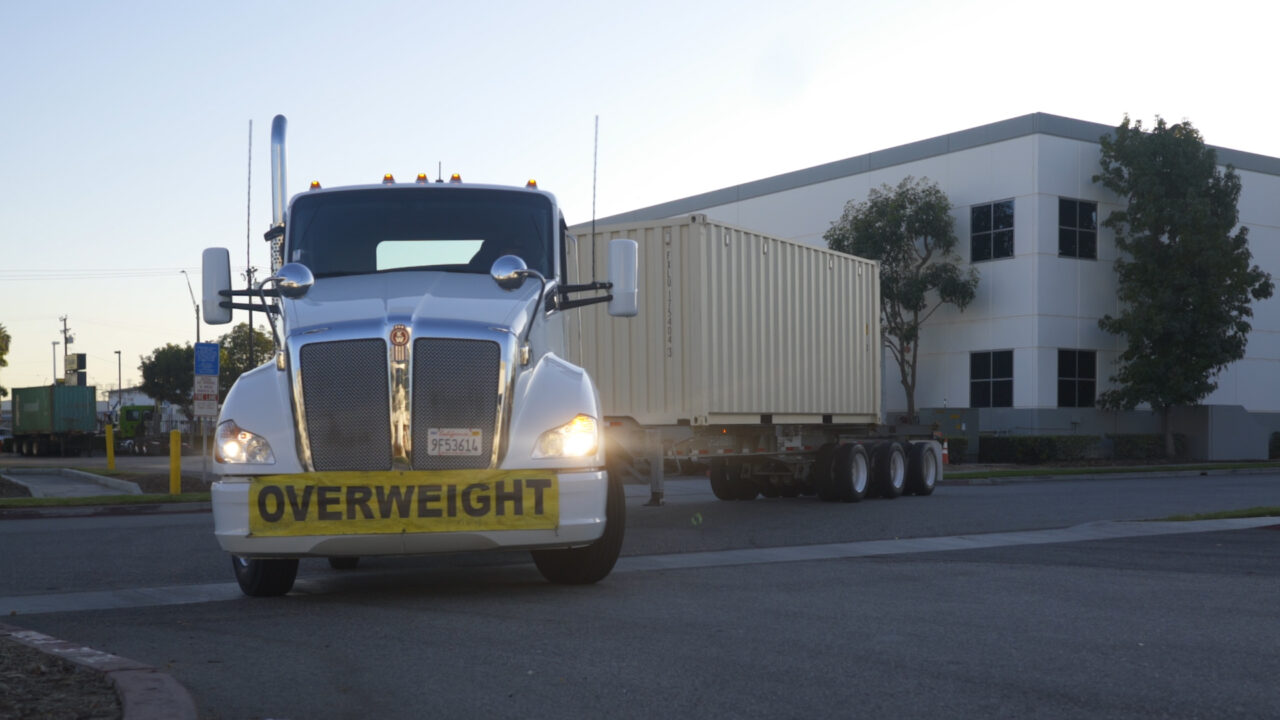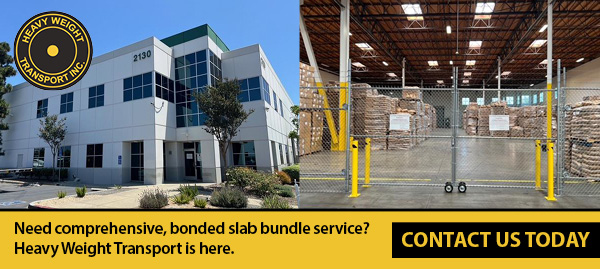Transporting heavy, fragile stone slabs — such as granite, marble, and tile — demands specialized expertise, robust safety protocols, and dynamic logistics solutions. In 2025, the surge in global construction and evolving supply chain complexity make it more important than ever for shippers to proactively address slab bundle drayage challenges with the latest tools, technology, and industry-backed best practices.
Heavy Weight Transport, a national drayage leader for over 40 years, shares top tips for safe, efficient stone transport and storage to ensure reliable shipping and warehousing of slabs.
The Unique Challenges of Stone Slab Transportation
Stone slabs are not only heavy — often weighing thousands of pounds per bundle — but also highly brittle until installed. Shippers face multiple challenges, including:
- Preventing Damage: Even minor mishandling can cause costly cracks or chips.
- Complying with Regulations: Overweight shipments frequently require specialized permits and careful route planning
- Ensuring Safe Handling and Storage: Both injuries and material losses can result from improper loading, unloading, or storage practices.
- Minimizing Delays: Timely delivery is crucial to construction timelines and cost control.[1][2][3][4][5]
In our work with clients in a wide variety of industries, we’ve observed what a U.S. Department of Labor report continues to show: Safety is paramount for proper handling and storage of stone slabs to avoid fatalities and serious citations.
Safety is the cardinal rule Heavy Weight operates by daily for transporting, unloading, storing, and handling slab bundles. We go above and beyond industry safety standards through:
- Mechanical Handling and Equipment Controls: Using mechanical devices (forklifts with appropriate attachments, cranes, slab lifters) avoids manual lifting. Drivers and crew receive specialized training on safe operation and inspection of equipment before each use.
- Standard Operating Procedures and Training: Documented Standard Operating Procedures (SOPs) and safety training for each stage: securing, lifting, unloading, and storing slabs are enforced. Access to the “fall shadow” is restricted.
- Compliance With Regulatory Guidelines: Operations comply with OSHA, DOT, and industry safety standards for cargo securement, equipment use, and workplace practices.
Industry-Leading Solutions and Innovations for Success
To ensure safety, keeping up to date with proper packing, restraint, and securement is necessary. All stone slab bundles should be tightly wrapped, strapped, and stabilized inside containers to prevent load shifting in transit. In addition, the drayage provider must be up to date with compliance issues and technology. This is ensured with:
- Specialized Equipment and Handling
- A-Frame Carts and Self-Locking Trolleys: These provide upright, stable, and shock-absorbing support for slabs, minimizing the risk of tipping or breakage. Vertical storage maximizes warehouse efficiency and safety.
- Slab Lifters, Clamps, and Cranes: Purpose-built lifting equipment with secure clamps allows precise, low-risk placement and movement. Mechanical aids and powered industrial trucks (with proper attachments) are the standard recommendation to avoid manual handling hazards.
- Demountable Transport Frames: Recent research highlights modular frames with locking and protective mechanisms that offer superior security and ease of use during both transit and warehouse storage.
- Integrated Permitting and Compliance
Stone slab drayage often requires:
- Timely Acquisition of State and Local Overweight/Oversize Permits: DOT or local agencies issue these for brief windows aligned with transport schedules. Missing or mismanaging permits leads to significant fines or delays.
- OSHA and DOT Safety Compliance: Compliance includes best practices for cargo securement, proper equipment use, and rigorous employee training.
- Real-Time Visibility and Smart Tracking
- Advanced Tracking Technology: RFID tags, barcodes, and real-time logistics platforms let shippers monitor the exact location and condition of each slab bundle throughout the supply chain. Immediate alerts address unexpected delays, environmental exposure, or handling issues.
- Temperature and Humidity Controls: Modern warehouses integrate these controls to protect sensitive stone from cracking due to environmental fluctuations.
- Custom, End-to-End Logistics Solutions
Partners like Heavy Weight Transport collaborate with organizations such as the National Stone Institute (NSI) and the Ceramic Tile Distributors Association (CTDA) to deliver tailored solutions. Their services typically include:
- 24/7 Shipment Monitoring: Full visibility and communication from port to final destination.
- Secure, Purpose-Built Warehousing: Facilities feature alarm systems, periodic security checks, and highly trained personnel for unloading and storage.
- Flexible Logistics Planning: Close attention to scheduling, route optimization, and last-mile drayage ensures timely and damage-free delivery regardless of project complexity.
It’s a Fact:
Heavy Weight Transport has three warehouses inside the Overweight Container Corridor near the ports of Los Angeles and Long Beach, California — including a bonded facility, allowing shippers to store imported goods for a period of up to five years. Heavy Weight is the only resource within the corridor that handles bundled slabs and slab handling.
Get Your Custom Drayage Quote Today
Best Practices Backed by Research and Industry Standards
- Always keep slabs upright in A-frame racks or transport frames and avoid horizontal stacking, which increases breakage risk.
- Use cushioned supports and proper spacing (such as padded racks and soft pads) to prevent collision damage during both storage and transit.
- Inspect all equipment and racks before use; never use damaged or overloaded systems.
- Plan clear, obstruction-free pathways for slab movement in warehouses and on jobsites.
- Continually train staff on safe handling techniques, the latest equipment, and emergency protocols.
- Embrace emerging tech: Many top logistics providers now employ AI-optimized delivery routes and smart weight sensors to reduce manual error and maximize efficiency.
Heavy Weight Transport uses an in-house proprietary Transportation Management System (iTMS) for our trucking and drayage operations. Our system allows us to completely automate internal processes from order receipt to customer service, to operations, to billing, and driver settlements.
Additionally, we have an in-house Warehouse Management System (WHMS) linked directly to our iTMS that allows us to manage our transloading inventory without logging inventory into our storage and distribution software.
Final Words on Slab Bundle Drayage
The safe, compliant, and efficient transportation of stone slab bundles depends on integrating the best of modern logistics technology, equipment, and industry knowledge. By partnering with experienced slab drayage specialists, leveraging advanced safety tools, and adhering to evolving regulations, shippers can confidently meet the toughest challenges head-on — delivering every slab safely, on time, and in pristine condition.










